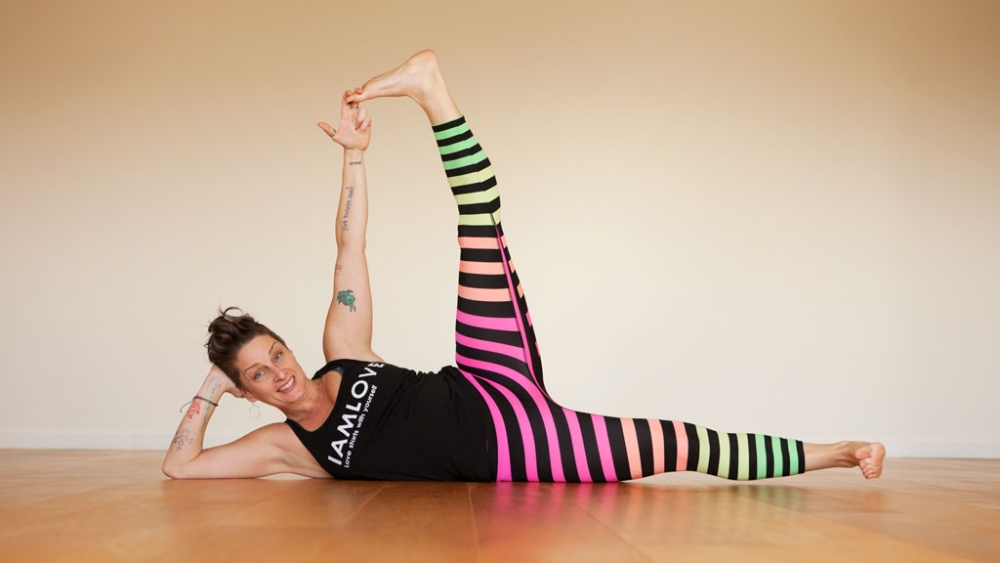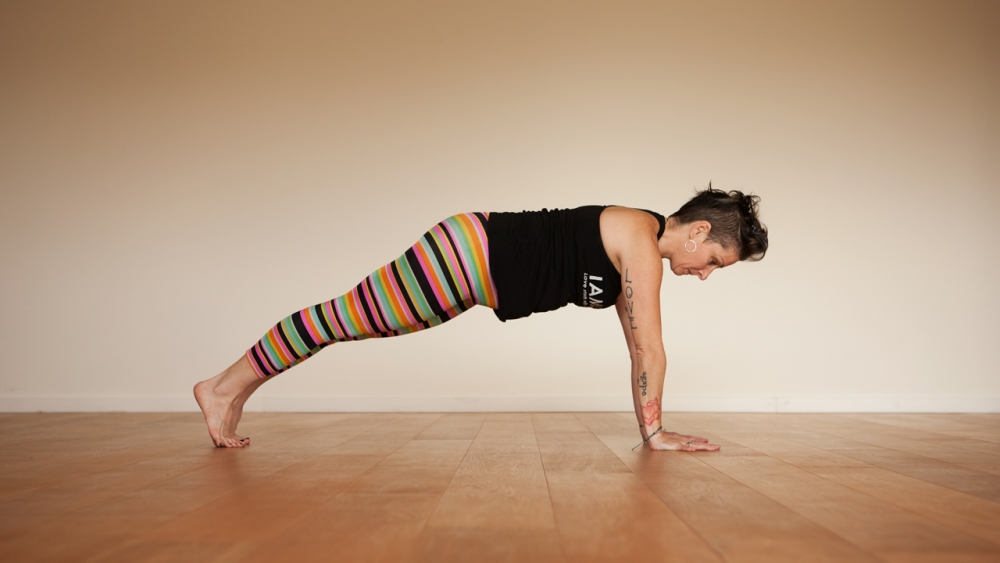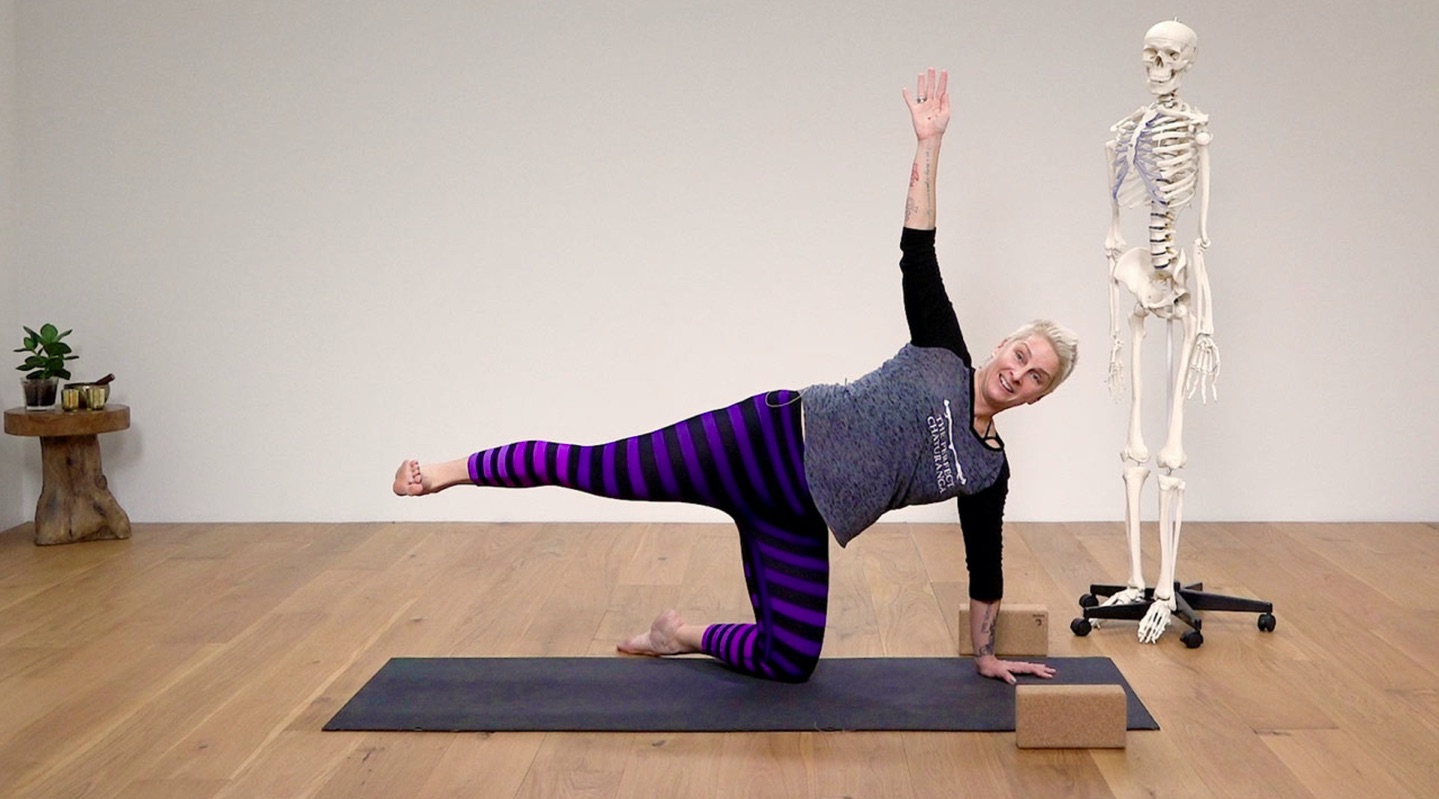Every Tuesday afternoon I teach a 45-minute core yoga class to a dedicated group of physically fit rockstars. Due to the tendency for many people to think the core is the gut region of the body (“abs”), I always begin the class by describing the 3 ways we are going to view, feel, strengthen and stretch the core: Apple Core Theory, Deep Core and Deep Frontal Fascial Plane.
Apple core theory
Visualize an apple core – a core that runs from the top of the apple to the bottom. The Apple Core Theory of the human body is from crown to tail – the 31-33 bones of the spine (the vertebral column). To keep the spine healthy both on and off your yoga mat, it’s important to move it regularly through all three planes of movement – flexion and extension in the sagittal plane, lateral flexion in the coronal plane, and rotation/twisting in the transverse plane. By introducing arm and legs movements away from the core, you add an increased strength element to the exercises (long levers will always efficiently and effectively challenge the core strength!)
Below are three mini-asana flows for each approach, to strengthen and add suppleness to the core, along with a class where I demonstrate some of the exercises.
3 mini flows to wake up and strengthen your ‘apple core’
1. Extended Cat/Cow (10 repetitions each side)
Inhale: From Table Top position extend either just right leg OR left arm and right leg to strengthen back extensor muscles.
Exhale: Draw either just right knee to temple OR draw left elbow and right knee towards each other to strengthen torso and neck flexors (rectus abdominis and sternocleidomastoid muscles or SCM).
2. Eagle Abs Warrior One (5-7 repetitions each side)
Inhale: From Classical Warrior One send your Eagle arms forward and up to strengthen back extensor muscles.
Exhale: Flex into yourself drawing your head and Eagle elbows down and in towards navel and mat space, to strengthen rectus abdominis and SCM.
3. Beach Ball Warrior Two (5-7 repetitions each side)
Inhale: Arms overhead in Warrior Two (as if holding a big beach ball)
Exhale: Keeping arms overhead, lean entire torso towards front knee as if moving towards Extended Side Angle pose to strengthen torso lateral flexors and stabilizers (quadratus lumborum, obliques, transverse abdominis).
Inhale: Reach up and overhead to Beach Ball Warrior Two and continue to move towards arms overhead into Reverse Warrior to strengthen the other side (quadratus lumborum, obliques, transverse abdominis).
Continue moving forward and back in lateral flexion with the support of breath.
Deep core
Your deep core comprises the muscles that stabilize the space between your ribs and pelvis (iliac crest and sacrum to be more specific). The four primary muscles/muscle groups that do this are:
- deep erector spinea (multifidus muscles that run from the spinous process of one vertebra to the transverse process of the next);
- diaphragm (major muscle of breathing the separates the thoracic cavity of heart and lungs with the abdominal cavity of organs of digestion, assimilation and elimination);
- transverse abdominis (your corset abdominal muscle that holds and supports everything in the space between the ribs and pelvis), and;
- the sling of three muscle layers that comprise your pelvic floor (Levator ani: pubococcygeus (pubovaginalis, puborectalis) and iliococcygeus being some of the many short, thick muscles found here).
3 mini flows to challenge and strengthen your deep core
1. Plank with Three- and Two-points of contact (7-10 repetitions each side)
Inhale/Exhale: Plank pose with shoulders stacked over elbows and wrists. Feel your ribs widen on inhales and narrow on exhales (bellows-style breathing to wake up and strengthen transverse abdominus – your “corset”).
Inhale: Touch right shoulder with left fingers. Try to keep hips stable – minimize shifting.
Exhale: Return to plank. Repeat on other side.
*Option for more challenging two-points of contact: Reach right arm forward and lift left leg on inhale (minimize shifting and tilting), exhale return to plank, switch to left arm and right leg.
2. Crouching Tiger with Weave through kicks (5-7 repetitions each side)
Exhale: From Table Top position lift knees to hover 1-3 inches off the mat.
Inhale/Exhale: Hold here and use your transverse abdominis/corset to hug everything to midline and lift lower belly).
Exhale: Spin left heel down to the right (think Warrior Two foot). Tuck right knee towards the left side of the ribcage. Extend your right leg, kicking the side of your mat space with your hovering heel, as you lift your left hand to touch your heart.
Inhale: Return to Crouching Tiger/hovering tabletop. Repeat on the other side.
3. Swimming Locust (10-15 repetitions each side)
Inhale: Lying prone on the mat with arms reaching forward, lift your arms and legs into Locust to strengthen your deep erectors and superficial back extensors.
Exhale: Stay lifted and engage your transverse abdominus/corset.
Inhale: Lift your right arm and left leg higher.
Exhale: Neutral Locust (arms and legs lifted). Repeat on the other side.
*Feel free to pick up the pace and inhale right arm/left leg, exhale switch to left arm/ right leg.
Expand your awareness of the deep core with Jennilee – 35 mins
Deep frontal fascial plane
Thomas Myers introduced the concepts of planes/meridians/lines of fascia (connective tissue that, among other qualities, glues everything in the human body together) in his 2001 book, Anatomy Trains: Myofascial Meridians for Manual and Movement Therapists. One of my favorite planes of fascia to teach awareness of is the Deep Frontal Fascial Plane, a deep sheath of fascia that runs from the soles of the feet, up through the arches, up the inner calf, inner knee and inner thigh into the pelvic floor where it supports and lifts all our internal organs).
In yoga we teach activating and lifting through the bandhas (internal locks). This deep frontal line corresponds to this practice: energy lifted from pada bandha (foot) up to Mula (root), Uddiyana (upward flying) and Jalandhara (throat) bandhas is an amazing support system in all our standing and balancing postures.
- Learn more: The Bandhas – preventing yoga injuries
- Practise in class – Front line opening with Sandra Carson – 45mins, Level 1, Vinyasa Flow
3 mini flows to enliven your deep frontal fascial plane
1. Thread the Needle variation (5-10 repetitions each side)
Inhale: From Table Top position step right foot out directly in line with the right of hip, foot flat on floor parallel to mat space, leg parallel to the front of the room.
Exhale: Make sure to seal the little toe side down, creating an arch. This arch activates your inner leg line (deep frontal fascial line).
Inhale: Lift right arm in the air, following arm movement with your eyes and head.
Exhale: Thread your right arm through the “eye of the needle” (space underneath your ribs) and wrap your right arm around your left rib cage. Continue to press down on the little toe side of your right foot, creating the arch and energizing/lifting the inner right leg.
Inhale: Right arm to the ceiling once again.
2. Vishnu’s Couch leg lifts (5-10 repetitions each side)

Inhale: From a side lying position, reach for big toe (feel free to use strap around bottom of foot) and extend top leg to the ceiling/sky (Vishnu’s Couch Posture – see picture).
Exhale: Activate your inner leg lines by flexing your feet and lifting bottom leg an inch or two. Feel you are awakening from arch to pelvic floor, into the deep core.
Inhale: Hover your lower leg with very active feet, maintaining stacked hips.
Each exhale: Lift your lower leg a little higher. Each inhale: Hold leg at highest height or lower back to starting position.
3. Tapping foot Visvamitrasana variation (5-10 repetitions each side)
Inhale: From Downward Facing Dog lift your right leg.
Exhale: Weave your right knee towards your left shoulder, spin left foot down like Warrior Two, as if practicing the above-mentioned Crouching Tiger with weave-through kicks. This will wake up and activate your deep frontal fascial lines. Extend right leg and tap right foot with lifted left hand.
Inhale: Return to One Legged Downward Facing Dog.
Each exhale: Try to extend the right leg a little more, taking hold of the right foot with the left hand, drawing the foot a little closer to the right ear.
A final word…
When reading some of these mini-flows to awaken, enliven and strengthen your core you may be chuckling at the level of difficulty. This is good…laughing, chuckling, giggling, chortling and snorting all are great for activating and enlivening your deep core 🙂


